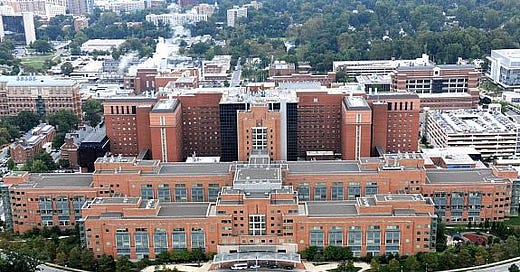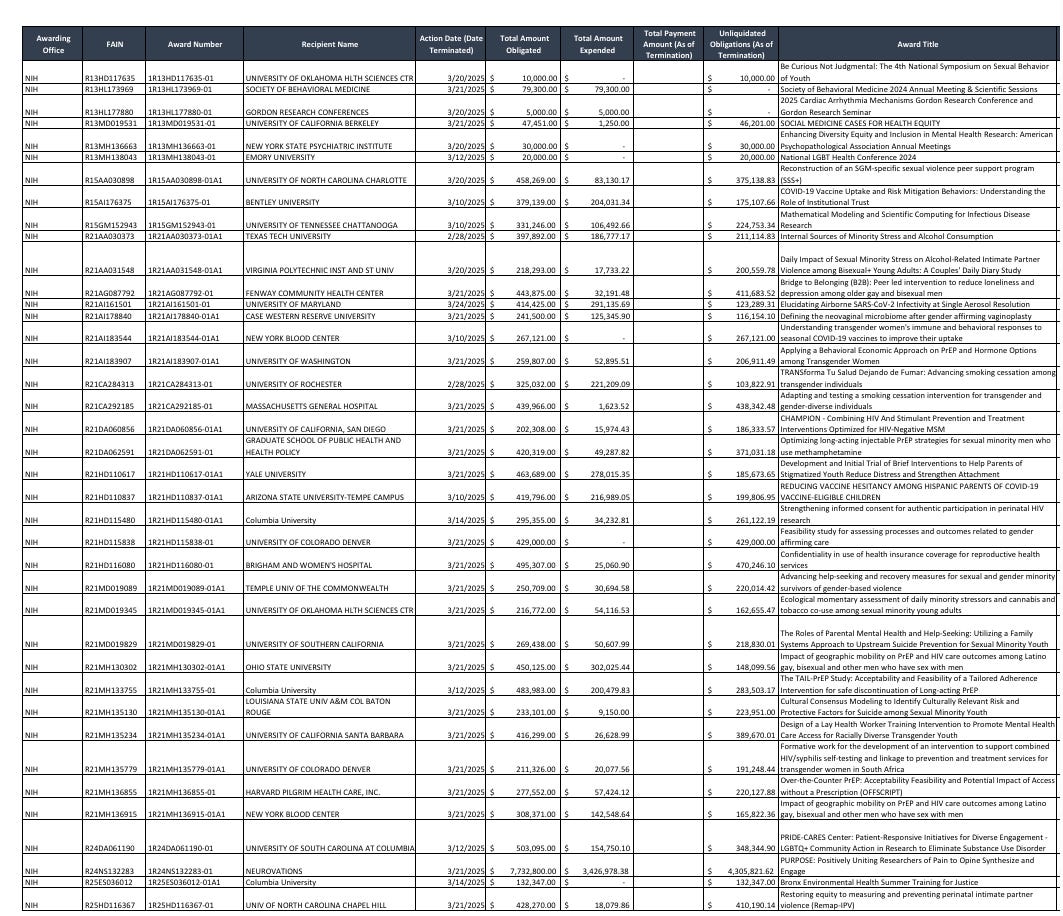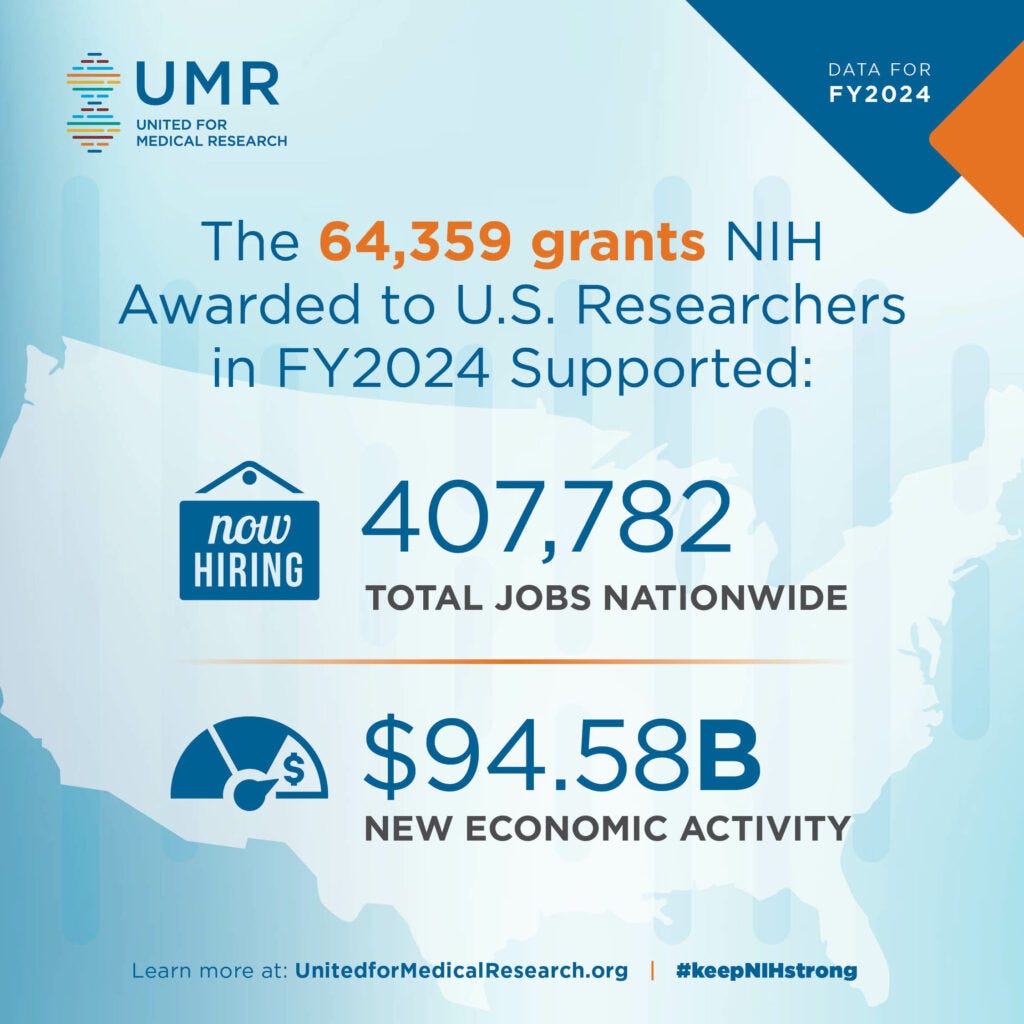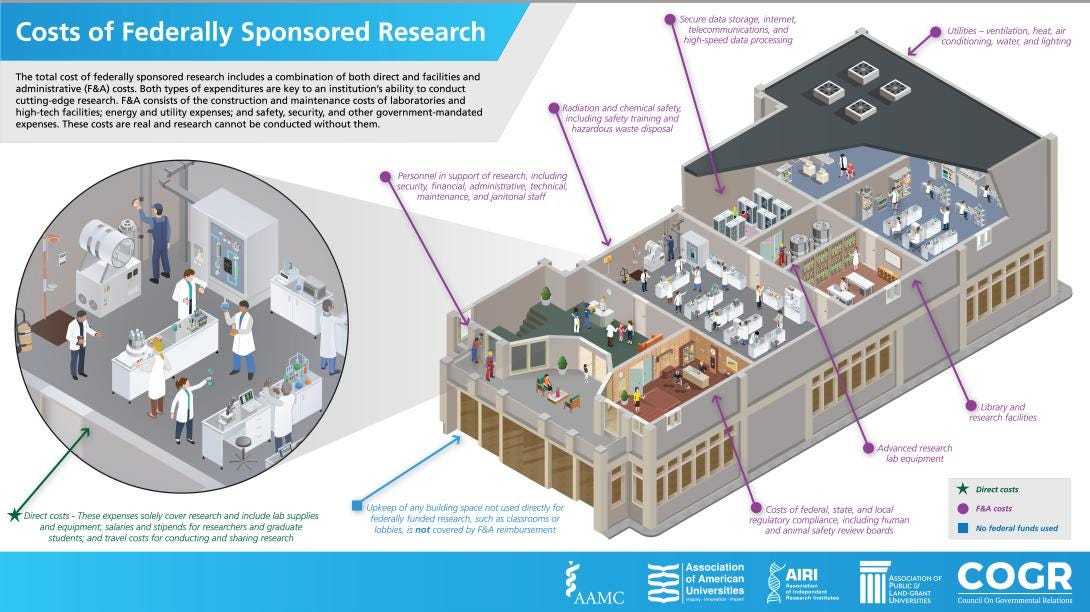Neighbor Tuesday: NIH updates - grants, indirect rates, and leadership changes
NIH funding is good for the health of the economy and its people.
Hi neighbors,
I’m sure you’ve seen *all* the headlines about NIH changes to grants, indirect rates, and leadership. Let me tell you why it matters and bring you up to speed. And tell you why NIH-funded research is good for the economy!
NIH Grant updates:
As I’ve mentioned, my entire team (including myself) is funded through an NIH grant. The National Institutes of Health (NIH) has been the overwhelming force to improve health and the economy. For those of you who are history nerds like myself, you can trace NIH’s start back to 1798 when the Marine Hospital Service was established to provide healthcare to merchants. Fast forward to the 1880s, and the Marine Hospital Service was charged by Congress to prevent epidemics by looking for signs of infectious diseases on arriving ships (think cholera and yellow fever). A young physician who was trained in laboratory work, Dr. Joseph Kinyoun, was hired to set up a one-room lab at the Marine Hospital in Staten Island, NY to do just that. In 1891, the lab was moved to DC, and in 1930, the name was changed to the National Institute (singular) of Health. Shout-out to the first woman, Dr. Ida A. Bengston, who was hired as a bacteriologist in the Lab!
Seven years later, the National Cancer Institute (this, along with the Fogarty International Institute, is where I’m funded!) was created with a unanimous ‘yes’ from every Senator! In 1940, President Roosevelt dedicated the NIH campus that now sits in Bethesda and is comprised of 27 institutes with 18,000+ employees - ranging from infectious diseases, cancer, mental health, disparties research, international health… I was just at this campus a few months ago, and it is stunning. Did you know the Clinical Center on the NIH campus is the world’s largest hospital devoted entirely to clinical research? This means that new treatments happen quickly from the lab to us.
What about NIH grant cuts?
To me, at its core, the NIH is about helping people and equity. Many of us scientists devote our lives to this work - gladly! So, the restructuring and taking away grants is devastating to an entire generation of scientists like myself. Let me show you. I am on a K01 award - this is a type of NIH grant given to early-career investigators (think pre-tenure) who are just getting started and need some funding to get their research going. This K01 provides 100% funding for my team and 75% of my salary for 5 years to get going. To say I’m thankful for this grant is an understatement. For many of us, NIH is the reason we can do our jobs.
All of that is being upended now with the unprecedented gutting of NIH grants. (Also, can we please get a ‘precedented’ time? Like it would be awesome to have a precedented year, am I right?) Alas, that is not the case right now.
To date, billions of dollars in grants have been canceled. But, as with all things right now, the impact is not equal. In the past month, 400 grants have been canceled- all of which deal with diversity, equity, inclusion, LGBTQ+ research, COVID/pandemic response, women’s health, minority health, and (one of the hardest one to type) early-career scientists. If you look at the 42 pages of cancelled grants (so far - 42 pages!), pages and pages of them are for early-career scientists like myself (in the link, look for the grants starting with a ‘K’ in column 2) or for students (look for the F31 grants). Ok, I’m getting teary even looking at it, especially for the F31 grants for students. These are specifically for PhD students just getting started, and the grants provide SCHOLARSHIPS. It’s just devastating. Many of these students cannot afford their program without scholarships. Look also at the P01 grants - these are large center grants that fund LOTS and lots of people and are given to highly innovative projects that take large teams doing big dream-type-research. One at Duke was looking at the development of a Pan-betacoronavirus vaccine that would work better than our current vaccines against new strains of COVID - cancelled. Below are screenshots of some of those 42 pages. They are not meant to be read - but, I wanted you all to focus in on the immensity of cancelling even one of those grants means cancelling a student working with community health centers for migrant children, a young investigator researching women’s health, a seasoned scientist working on life-saving cancer treatments, and all of their teams. I don’t really know how to put this into words, but I hope you’re feeling the emotion of it. It’s devastating. For those of us in limbo, it’s also scary.
The first screenshot is page 1 of 7 of cancelled grants for children's vaccine development and the second is page 1 of 8 of grants for the prevention of future pandemics. The 3rd and 4th screenshots are for grants and programs looking at immigrant health, community health centers, AIDS research, minority health…The cancellation of these grants leaves us all vulnerable to health threats and diseases.
The foundation of NIH research is centered on equity, population health, and economic development. Gutting hundreds of us is not that.
Let me show you how NIH helps the economy and why cutting it will do the opposite.
It is not hyperbole to say that NIH-funded research has been the best investment in ALL people’s health to date. When you think of breakthroughs in cancer therapies, treatments against infectious diseases, vaccines against deadly diseases for children (like polio, measles, and rubella), you can almost always trace it back to the NIH.
With a budget of $48 billion, the NIH is the largest funder of biomedical research in the world. To put this into context, $48 billion is less than 1% of the overall federal budget. So, gutting it with cuts to grants is not cost-saving. Neither was cutting USAID or foreign aid. Cuts to NIH COMBINED with cuts to USAID and foreign aid will only save about 2% in federal spending. It’s not saving money to cut. It’s a smoke screen.
In 2024, a study found that every $1 invested in NIH programs/research produces $2.56 in economic activity, resulting in $94.5 BILLION to the economy. Investing in NIH (and all the staff, scientists, students, etc) is good for our personal health - and also good for the economy’s health too.
What are NIH indirect rates, and why are they important to scientists?
You might have seen the news about universities having cuts to their indirect rates. These rates aren’t talked about around dinner tables, so you might not know what they mean. Let me help. When I first received my NIH-funded K01 grant, I received funding for my salary, my staff’s salary, and any research needs I have (like traveling to Tanzania, laboratory supplies, diagnostic testing, materials, etc). In addition to that funding, my university also received funds called indirect funds. But, don’t believe the misinformation that universities get rich or make money off of these indirect funds. In fact, it’s not the case at all!
So, what do indirect funds go towards? Universities use them to hire staff that support the scientists. Let me tell you why that’s important. I have worked at 2 universities - one with a high indirect rate and the other with a lower indirect rate. And the difference is huge! The university with the higher indirect rate had an incredible support infrastructure for scientists. When I wanted to apply for additional funding, when I needed to do the financial audit of my projects, when I needed help navigating how to pay my team in Tanzania, the indirect funds helped pay for people to help me with all of that! If universities do not have indirect funds to support scientists, we (the scientists) have to do it all ourselves. And, that takes a LOT of work. Think of your job and who helps you do it well. If you’re a teacher, that’s the principal, the always-awesome administrative staff, the janitorial staff, etc. Now imagine losing all of that and now you were doing the work of 5, 6, 7 people. That would be like losing indirect funding to scientists. So, indirect funds allow for universities to hire the support needed to do good science. And employs lots of great people along the way.
Indirect funds also help pay for buildings for us to work in, janitorial and maintenance staff for the building, heating and air, etc. In other words, it keeps the lights on! The graphic below is small - if you zoom in on it, everything in the purple-ish (magenta?) is funded through indirect funds.
With a reduction in indirect rates, universities will lose a lot of money. This translates into loss of staff, possible tuition hikes, etc. In the table below, you can see the potential losses in the far right column for select universities. The new administration is wanting to cut indirect rates to 15%. If you look at UT Southwestern, that would be a 40% loss, equating to a loss of $160 million.
In summary, indirect funds help support scientists to do their work with efficiency, incredible teams, and with the lights on. It does not make universities rich. It actually equips scientists to do their jobs well - and, to bring it full circle, that in turn means a healthy population and economy.
What about recent leadership changes at the NIH?
I recently wrote about Dr. Francis Collins departure from the NIH after decades of groundbreaking work (remember the Human Genome Project?) and serving as NIH director from 2009 to 2021. The new NIH director is Dr. Jay Bhattacharya, a health economist from Stanford with a confirmation vote along party lines (53-to-47). Now, let’s go way back to the COVID pandemic. Do you remember me telling you about the Great Barrington Declaration? It was a ‘declaration’ signed in October 2020 which was basically a ‘let it rip’ strategy. I, along with lots of others, vehemently wrote against it because it ignored tried-and-true public health measures on the basis of just letting the virus ‘run’ its course. It also ignored any type of equity because those that would be most affected by this strategy were the elderly, the frontline workers, and other vulnerable populations on the margins of poverty or poor healthcare access. It was, and is, reckless and not guided by science. One of the 3 authors on the Declaration was none other than Dr. Bhattarcharya. This declaration was also a political statement as it was in large part supported by a right-wing think tank - but that’s for another post.
With Dr. Oz leading the Centers for Medicare and Medicaid, RFK Jr. leading HHS, and now Dr. Bhattacharya in at NIH, the door is wide open for pseudoscience which is already getting started. There has already been a shadow CDC page on vaccines and autism that looked just like the real CDC page. But the shadow one was funded by the Children’s Health Defense which is what RFK Jr. led prior to his HHS nomination (and a leading anti-vaccine and misinformation group). The imposter site has now been taken down, but it goes to show what we are up against. Another example is funding for a "new” study on vaccines and autism, funded by the new NIH leadership and led by David Geier, a vaccine skeptic and widely discredited ‘researcher’ (he was disciplined by Maryland for practicing medicine without a license). Geier has long promoted misinformation that thimerosal led to autism rates (which has been widely debunked) along with other misinformation claims- but that’s for another post too.
I guess what I’m trying to say is be very, very wary of ‘science’ from certain groups right now. I, along with every other scientist I trust, are deeply worried about these leadership changes, imposter websites, “new” studies, etc. You should be too. I will be here to help you sift through what is real or not. But, put on those thinking caps, call your Congress people and ask for NIH grants and indirect rates to not be cut, and harness wisdom on what you hear from TV pundits or across restaurant tables.
Onward we go,
Emily
PS: A huge thank you to those of you who commented about my last weekend personal post. It seemed to resonate with so many of you, and I’m glad it could help bring a little hope these days. Hang in there, friends!













Thank you, Emily. The scope of this post is immense, as are the despicable, heartless, and senseless attacks on both government and private institutions and agencies. You brought home this message in a clear, powerful, and courageous way. The post is important on so many levels: the human (and humane), individual and population health, economic, scientific, historical, even the nitty-gritty of indirect costs. I think daily of you and others like you at universities and foundations and government agencies. These shortsighted and cruel assaults on vital, highly regarded, irreplaceable people and institutions will result in preventable and irreparable harm to millions in this country and abroad. Thank you for standing up for what is good and right.
Thank you so much for your fact based posts. I work in healthcare and am terrified of the recent changes erasing research and basic science.